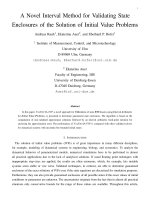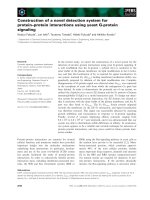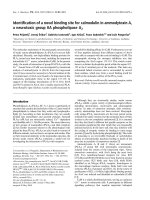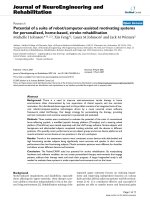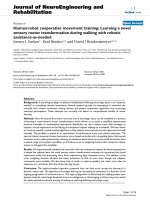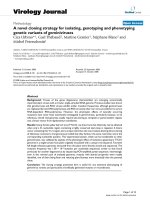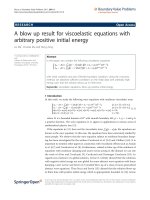A novel packet scheduling for wireless channels with adaptive burst profile
Bạn đang xem bản rút gọn của tài liệu. Xem và tải ngay bản đầy đủ của tài liệu tại đây (198.79 KB, 7 trang )
A Novel Packet Scheduling for Wireless
Channels with Adaptive Burst Profile
Do Hoai Nam, Luong Dinh Dung
Department of Telecommunications
Budapest University of Technology and Economics
H-1117, Magyar tudósok körútja 2, Budapest, Hungary
Email: {nam,luong}@hit.bme.hu
Consequently the selected burst profile is used for the
respective subscriber station on the uplink.
Abstract- This paper proposes an Adaptive Profile Packet
Scheduling (APS) algorithm for the down-link of IEEE
802.16 W-MAN, which is identified as a candidate
standard for High Attitude Platforms (HAP) in the EU
IST CAPANINA project. The proposed APS takes into
account different wireless channel conditions observed by
different subscriber stations to enhance the whole system
utility and preserves the property of the long-term
fairness.
Typically a HAP is an airship that floats at an
altitude of around 20km, well above any normal aircraft
but being in the stratosphere, substantially below
orbiting satellites. CAPANINA will deliver low cost
broadband communications services to small office and
home users at data rates up to 120Mbit/s - a staggering
2000 faster than today's dial-up modems and more than
200 times faster than a typical "wired" broadband
facility [1].
Keyworlds: Packet Scheduling, Wireless Access, Burst
Profiles.
I.
INTRODUCTION
CAPANINA
(Communications from
Aerial
Platform
Networks
delivering
Broadband
Communications for all) is an international cooperation
supported by the European Union under Framework 6
Research Programme. The CAPANINA project will
develop wireless and optical broadband technologies for
use on High Altitude Platforms (HAPs).
In such environment, effective packet scheduling
algorithms should consider channel conditions in order
to enhance system performance. It has been shown that
while General Processor Sharing (GPS) and Packet Fair
Queuing (PFQ) algorithms guarantees fairness and
guaranteed service in wired networks, they cannot
satisfy both in a wireless environment where wireless
channels may be blocked by errors. Eugene et al.[7]
define a set of desirable properties called CIF that a
scheduling algorithm should satisfy in the context of
location-dependent channel errors. They also propose a
scheduling algorithm called CIF-Q and prove that CIFQ achieve all CIF properties.
IEEE 802.16 is identified as a candidate standard for
HAP in the CAPANINA project. The standard specifies
QoS classes for the connection on the uplink. However,
the scheduling algorithms to realize QoS requirements
on the uplink and scheduling algorithms on the
downlink are not standardized. The subscriber stations
measure the level of the received signal and request the
best-suited burst profile from the base station which
includes the byte per symbol rate with that the base
station can send data to the Subscriber Station (SS) on
the downlink. Similarly, the base station measures the
level of the received signal from subscriber stations and
decides upon the best burst profile for each of them.
In many works, e.g. [6], [7], the wireless channel is
modeled with two states: error-free and erroneous.
Sessions in error state will offer their service share to
sessions in the error-free state and claim it back when
they switch to the error-free state. Recently, different
adaptive mechanisms such as adaptive modulation and
channel coding have been proposed to enhance system
18
Moreover, this work does not heavily depend on the
specific properties of IEEE 802.16 and therefore, the
algorithms can migrate to other wireless access
environments, which apply adaptive profiles.
capacity. The channel can be in multiple states and each
state is assigned with a combination of mechanisms
called burst profile to maximize the data rate while
maintain the bit error rate (BER) under a certain
threshold.
The rest of the paper is organized as follows. In
Section II, we briefly describe the operation scenario. In
Section III, we present the proposed scheduling
algorithm. In Section IV, we investigate and compare
the performance of the APS with the Fair Queuing.
Section V concludes our work.
To use the burst profiles in an efficient manner,
packet scheduling needs to be developed to achieve
high system throughput while maintaining QoS and
fairness conditions. On the downlink, since a minimum
reserved rate is the basic QoS parameter negotiated by a
connection within an 802.16 scheduling service, the
class of latency-rate scheduling algorithms is
particularly suited for implementing the schedulers in
the 802.16 MAC as discussed in [9]. Some other works
on the packet scheduling on the up-link [4], [5], [8] of
IEEE 802.16 focused on satisfying requirements of
different QoS classes but they did not consider the
dynamics of the wireless channel’s condition.
II.
In our previous work [10], the cross-layer packet
scheduling algorithm was proposed in multi-state
downlink wireless channel of IEEE 802.16 W-MAN
networks [2] operating in a point-to-multi-point
communication scenario, which takes into account
different wireless channel conditions observed by
subscriber stations to enhance the system throughput.
The additional aim is to preserve the property of the
long-term fairness and the guaranteed rate for each user,
as well as simple implementation and low complexity.
The efficiency of scheduling algorithm depends on the
freedom degree p, which controls fairness for all users,
but p factor is vary on different systems and difficult to
obtain.
OPERATION SCENARIO
Fig 1. A typical operation scenario in HAP systems
Consider a wireless network with a base station (BS)
and N subscriber stations (SS) working in point-tomulti-point communication scenario. As shown in Fig.
1, in a typical operation scenario of HAP systems
targeted in CAPANINA project, both fixed and mobile
SSs are considered with the mobile SS’s velocity up to
400 km/s. The data packets are segmented into fixed
size ARQ blocks and scheduled on the downlink with
Time Division Multiplexing (TDM) and Adaptive Burst
Profiles [2]. Data to be sent to SSs are multiplexed in
TDM frames which size is S symbols.
In this work, we solve the p freedom degree problem
with a novel approach. We propose a scheduling
algorithm which have a low complexity and is easy to
be implemented. The algorithm is based a cross-layer
system design exchange information between the MAC
and physical layers using Adaptive Modulation and
Coding (AMC) technique. Our scheduling algorithm is
referred to as the Adaptive Profile Scheduling (APS),
which can guarantee minimum rate and long-term
fairness while maintaining the high system utility.
An SS measures the received signal level sent by the
BS and decides which is the best burst profile for its
downlink transmission. The burst profile change request
then can be sent to the BS on the up-link. Let BP is the
set of pre-defined burst profiles. At any point of time,
each SS is assigned with a burst profile which consists
of a modulation and a channel coding technique, i.e. for
19
III.
the SS i at time frame k, a burst profile bp(i,k) is chosen
from BP with that a symbol can carry bps(bp(i,k)) bytes
of data. We assume that the chosen burst profile is
efficient enough to transfer data successfully to the SS.
The objective of the scheduling is to:
• enhance the overall throughput G,
At each frame, e.g. at frame k, the BS with a given
set of SSs and their assigned burst profiles must decide
how to transfer data. That is, n(i,k) symbols are
∑ n(i, k ) ≤ S
i =1
The data amount of all SS i packet in frame k:
D (i, k ) = n(i, k )bps (bp (i, k ))
(1)
N
N
i =1
i =1
∑ D(i, k ) = ∑ n(i, k )bps(bp(i, k ))
(2)
which has an upper bound:
D max ( k ) = max ( D ( k )) = bps ( bp best ( k )) S,
bp best ( k ) ∈ {bp (i,k )} ∀ i,
(3)
bps (bp best ( k )) ≥ bps (bp (l,k )) ∀ l.
Davg
m
j =1
D (i, j )
,
m
Davg
m
k =1
D(k )
m
The depth of the token buckets is upper bounded
( max1 and max2 ). ri is the minimum rate guarantee for
(4)
SS i. Slots of each TDM time frame are distributed
among SSs after five steps:
(i) In the first step, adequate slots are reserved
according to the guaranteed minimum rate of each SS
using the first token bucket.
(5)
,
for all SSs.
(ii) The second step guarantees the long-term
fairness for each SS by limiting the borrowed slots.
The throughput fairness index is defined according
to Jain et al. [13]
I ( m) =
∑
N∑
(
N
i =1
N
Davg (i, m))
i =1
provide a throughput guarantee of ri for each SS
i.
and second token bucket are t i1 and t i 2 , respectively.
for SS i and
∑
( m) =
•
Denote the FIFO buffer assigned to SS i for storing
MAC packets by queuei . The actual sizes of the first
Therefore, the average amount of data per frame
taken over m frame is
∑
(i, m) =
guarantee the long-term fairness,
The main principle of APS is that the SS with better
burst profile (higher bps) should borrow resources from
the SS with worst burst profile and gives back the
borrowed resources when its channel condition is bad.
This main principle is combined with some mechanisms
to guarantee the minimum rates and fairness. Two token
buckets are used: the first token bucket is for the
minimum rate guarantee and the second one is for the
fairness guarantee purpose.
The data amount of all SS-s packed in frame k can
be calculated as
D(k ) =
•
The proposed APS performs as illustrated in
Algorithm 1. We assume that each SS will be assigned
with a FIFO buffer at the BS. The MAC packets to be
sent to SSs are classified according to their receiver SS
address and put into the corresponding FIFO buffers.
N
assigned to SS i to carry its data, where
THE ADAPTIVE PROFILE SCHEDULING (APS)
(iii) The third step enhances the system throughput
by giving higher privilege to SSs with better burst
profile.
2
Davg (i, m) 2
(6)
(iv) In the fourth and fifth steps, the token buckets
are refilled.
The throughput fairness index takes values between
0 and 1. The closer the index to 1, the fairer the
scheduling.
In the fourth & fifth steps, the token buckets are
20
if filledsymno = S then
end the for loop and goto step 4
end if
refilled. The first bucket is refilled once in a rough, but
the second can be refilled more than once as the
following step of the second and the third steps. Those
three steps can be repeated as much as possible in order
to solve the starve problem: in some cases, some users
have data but they haven’t got enough tokens in the
second bucket to send out. Some others haven’t data,
but they have enough tokens to send. Those unused
tokens can be redistributed: users can borrow tokens
from others to send out their data, and will pay later in
another redistribution rough. By this way, we can
maintain the long-term fairness of the system.
end if
end for
{step 3 – Enhance system throughput}
{l1 ,l2 ,...,l N } is
a permutation of {1,2,..., N } , where:
bps (bp (l1 , k )) ≥ bps (bp (l 2 , k )) ≥ ... ≥ bps (bp (l N , k ))
for i = l1 to l N do
reserve
⎧⎪⎡
⎫⎪
⎤
datai
si = min ⎨⎢
⎥, ⎣ti2 ⎦, S − filledsymno ⎬
bps
bp
i
k
(
(
,
))
⎪⎩⎢
⎥
⎭⎪
for SS i
sharedsymno+ = si
The detailed code of APS is shown in Algorithm 1.
Algorithm 1 Description of the APS
filledsymno+ = si
datai − = min{datai , si * bps (bp (i, k ))}
{step 1 – For minimum rate guarantee}
ti2 − = si
filledsymno = 0
for i = 1 to N do
reserve
⎧⎪⎡
⎣ti1 ⎦ ⎤, ⎡ datai ⎤ ⎫⎪ for SS i
si = min ⎨⎢
⎥ ⎢
⎥⎬
⎪⎩⎢ bps (bp(i, k )) ⎥ ⎢ bps(bp (i, k )) ⎥ ⎪⎭
if filledsymno = S then
end the for loop and goto step 4
end if
end for
filledsymno+ = s i ;
{step 4 – Refill the second token bucket}
ti1 − = min{datai , ti1 , si * bps(bp (i, k ))}
data i − = min{data i , s i * bps (bp (i, k ))}
end for
if filledsymno = S then
goto step 5
end if
for
i=1 to N do
sharedsymno
ti2 + =
N
end for
if filledsymno < S then
{step 2 – For long-term fairness}
if
sharedsymno = 0
for i=1 to N do
if ti2 > max2 and datai > 0 then
reserve
⎧⎪⎡
⎫⎪
⎤
datai
si = min ⎨⎢
⎥, ⎣ti2 ⎦ − max2 , S − filledsymno⎬
⎪⎩⎢ bps (bp (i, k )) ⎥
⎪⎭
for SS i
sharedsymno+ = ti2 − max2
filledsymno+ = si
then
goto step 2
end if
end if
{step 5 – Refill the first token bucket}
for i=1 to N do
r *1000 * frametime ⎫
⎧
ti1 = min ⎨max1 , ti1 + i
⎬
8
⎩
⎭
end for
datai − = min{datai , si * bps (bp(i, k ))}
ti2 = max2
21
∃i, {1 ≤ i ≤ N | datai > 0 and ti2 < 1.0}
IV.
NUMERICAL RESULTS
was chosen to be 2000 symbols/ms. For traffic
simulation, an FTP download session has been initiated
on each client-server pair. Three different guaranteed
minimal bandwidth values: 400 kB/s, 600 kB/s and 800
kB/s have been used. During a simulation run, the
guaranteed bandwidth has been the same for all users.
In this section, we present some simulation results to
illustrate the utility improvement and the fairness of the
APS. The algorithm was implemented in the ns-2
network simulator [3] with parameters shown in Table
2. The wireless channel quality is characterized by the
received signal-to-noise ratio (SNR) which is
partitioned into 6 intervals with the thresholds of
A0 ,A1 ,...,A6 (Table 1), as suggested by Li et al. [12]. Six
burst profiles are assigned to these intervals with
different bps parameters (Table 3). The finite state
Markov channel model was constructed from the
Rayleigh fading channel as proposed in [11]. Time
variation of the signal levels is characterized by
Doppler frequency effect caused by the motion of
subscriber stations.
Fig. 3. The simulation topology
SNR threshold
A0
Value (dB)
A1
6.1
A2
8.8
The state transition of the Markov chain happens in
the frame time basis with the normalized transition
probabilities p ij shown in Table IV. In other words,
A3
11.6
A4
16.7
A5
18
p ij is the probability that the channel state changes to
A6
∞
Fig 2. The state transition between the Markov
chain’s states
0
Table 1 – SNR thresholds
burst profile j given the previous state is i and the
Doppler frequency is 10 Hz. Since the time frame of 1
ms is small enough, we can consider pij = 0 if | i − j |> 1 .
The Round Robin algorithm has been used to
compare with APS since the Round Robin is the only
general algorithm to be used in a multi-state channel
environment. We have measured the fairness index of
the flows and the average throughput provided by the
two algorithms in every case.
A transition probability equals to the corresponding
normalized probability multiplying the Doppler
frequency.
The network shown in Fig. 3 has been used to
investigate the performance of APS. The topology
consists of 20 FTP client-server pairs, a router and a
BS. The servers are connected to the router with a 2
GB/s link having a latency of 10 ms. The link between
the router and the BS has a bandwidth of 2 GB/s and a
latency of 50 ms. The BS offers a downlink of 2
Mbaud/s for the SSs with the FTP clients. The up-link
is emulated by a wired link of 2 GB/s. In this
configuration the wireless link is the bottleneck thus
congestion occurs only at the BS. The TDM frame size
Name
TDM frame size (S)
Channel capacity
Number of users(N)
Average SNR(ρ)
Doppler frequency f m
Value
2000 symbol
2 Mbaud/s
20
12 dB
10 Hz
Table 2 - Simulation parameters
22
Burst Profile Id
Intervals
bp0
( A0 , A1 ]
Bytes per
Symbol (bps)
24
bp1
( A1 , A2 ]
36
bp2
( A2 , A3 ]
48
bp3
( A3 , A4 ]
72
bp4
( A4 , A5 ]
96
bp5
( A5 , A6 )
108
users with a bad profile does. Thus, the higher the
number of unassigned slots the higher the throughput of
the system.
The simulation results show that the long-term
fairness is independent of the different scheduling
parameters. In all the cases, the long-term fairness index
has converged to the value of 1 as shown on Fig. 5.
Thus all user experiencing the same error distribution
receives the same throughput for their downloads. If the
error model is different for the users then users with a
good average SNR may have a higher throughput than
users with a bad average SNR. It can be also observed
that the minimum bandwidths ri are always guaranteed.
Table 3 -Pparameters of burst profiles
As shown in Fig. 4, the improvement of the average
throughput can be as high as 23.14 % with 400 kB/s
guaranteed bandwidth values. With different guaranteed
bandwidth, the improvement can be 22.17 % for the
600 kB/s case and 20.66 % for the 800 kB/s case.
1.000
0.950
Value
0.0027
0.0085
0.0094
0.0056
0.0044
Prob.
p10
p21
p32
p43
p54
Value
0.0089
0.0103
0.0071
0.0047
0.0075
fairness index
Prob.
p01
p12
p23
p34
p45
0.900
0.850
0.800
0.750
Table 4 - Transition probabilities of the markov chain
0.700
1
101
201
301
401
2900
A verag e th o u g h tp u t [kB /s]
501
601
701
801
901
Time[s]
400K
2800
600K
800K
Round Robin
2700
Fig. 5. The fairness index versus time
2600
2500
2400
V.
2300
This work has proposed a packet scheduling
algorithm called the APS to be used in the down-link of
IEEE 802.16 W-MAN networks operating in point-tomulti-point scenarios. Utilizing the different channel
conditions seen by subscriber stations, the APS
improves the system performance by up to 21% in a
normal configuration parameter setting while
preserving the long-term fairness and guarantees
minimum rates. The future work will be the extension
of the APS from IEEE 802.16 networks into a more
general wireless system. Furthermore, the application of
analytical models in [14] for the performance
evaluation is being considered.
2200
2100
2000
maxtoken2 = 1000
minband=400k
minband=600k
minband=800k
CONCLUSIONS
Round Robin
Fig 4. The average throughput of APS and Round
Robin versus the minimal guaranteed bandwidth
The simulation results show APS shares symbols
fairly among the SSs. The smaller the guaranteed
bandwidth the higher the number of unassigned slots.
APS shares these unassigned slots effectively since
users with good burst profiles receives more slots than
23
ACKNOWLEDGMENTS
[13]
The work is performed with the support of the IST
CAPANINA project 1 of the EU Framework 6
programme.
[14]
REFERENCES
[1]
[2]
[3]
[4]
[5]
[6]
[7]
[8]
[9]
[10]
[11]
[12]
1
CAPANINA project, .
IEEE Std 802.16-2001, IEEE Standard for Local and
Metropolitan Area Networks - Part 16: Air Interface for
Fixed Broadband Wireless Access Systems.
The
Network
Simulator
ns-2.
/>Mohamed Hawa and David W. Petr. Quality of Service
Scheduling in Cable and Broadband Wireless Access
Systems. In Proceedings of the Tenth International
Workshop on Quality of Service (IWQoS 2002), pp. 247 255, 15-17 May 2002.
GuoSong Chu, Deng Wang and Shunliang Mei. A QoS
Architecture for the MAC Protocol of IEEE 802.16
BWA System. In Proceedings of the IEEE 2002
International Conference on Communications, Circuits
and Systems and West Sino Expositions, pp: 435 - 439,
vol. 1, 29 June 2002.
W. K. Wong, H. Tang, Guo Shanzeng and V. C. M.
Leung. Scheduling Algorithm in a Point-to-Multipoint
Broadband Wireless Access Network. In Proceedings of
VTC 2003-Fall - The IEEE Vehicular Technology
Conference, Volume: 3, pp. 1593 - 1597, October 2003.
T. S. Eugene Ng, Ion Stoica, Hui Zhang. Packet Fair
Queueing Algorithms for Wireless Networks with
Location-Dependent Errors. In Proc. of IEEE INFOCOM
1998 - The Conference on Computer Communications,
no. 1, pp. 1103-1111, April 1998.
Yaxin Cao and Victor O. K. Li. Scheduling Algorithms
in BroadBand Wireless Networks. In Proceedings of the
IEEE, vol. 89, no. 1, January 2001.
C.Cicconetti, A.Erta, L.Lenzini and E.Mingozzi,
Performance Evaluation of the IEEE 802.16 MAC for
QoS Support. In IEEE Transactions on Mobile
Computing, vol. 6, no. 1, pp.26-38, January 2007.
Tien V. Do, G. Buchholcz, D. D. Luong. Scheduling for
broad-band wireless access with adaptive burst profiles.
In The First International Wireless Summit (IWS 2005),
(Denmark), September 2005.
H.S. Wang and N. Moayeri. Modeling, Capacity, and
Joint Source/Channel Coding for Rayleigh Fading
Channels. In Proc. of 43rd IEEE Vehicular Technology
Conference, pp. 473479, 1993.
Lingjie Li, Octavian Sarca FEC Performance with ARQ
and Adaptive Burst Profile Selection. IEEE 802.16
working document, 2001.
R. Jain and D. Chiu and W. Haweu A Quantitative
Measure of Fairness and Dicrimination for Resource
Allocation in Shared Computer System. Research
Report, TR-301, September 1984.
Ram Chakka and Tien V. Do, The MM\sum_{k=1}^K
CPP_k/GE/c/L G-Queue with Heterogeneous Servers:
Steady State Solution and an Application to Performance
Evaluation, Performance Evaluation, Volume 64 , Issue
3 (March 2007), Pages: 191-209, ISSN:0166-5316.
AUTHORS’ BIOGRAPHY
Nam Hoai Do received the M.Sc. in
telecommunications
engineering
from the Technical University of
Budapest, Hungary, in June 2006. He
is currently a PhD student at the same
university. His research interests
include quality of service in wireless
networks, the performance evaluation
and planning of cross layered
wireless systems, and scheduling algorithms for wireless
networks.
Dinh-Dung Luong received his
Ms.C. and Ph.D. degrees from
Budapest University of Technology
and Economics (BUTE), Hungary,
in 1998 and 2005, respectively.
From 2005 to 2007, he was with the
Multimedia Networks Laboratory at
BUTE. Currently, he is a
postdoctoral
fellow
with
Management Networks and Telecommunications Research
Laboratory at ETS, University of Quebec, where he conducts
research and development in cognitive wireless mesh
networks. His research interests also include network
measurements, network management, congestion control,
routing, MAC for wire- and wireless networks.
The CAPANINA project () involves
14 partners and is partially funded by the European Union.
24
